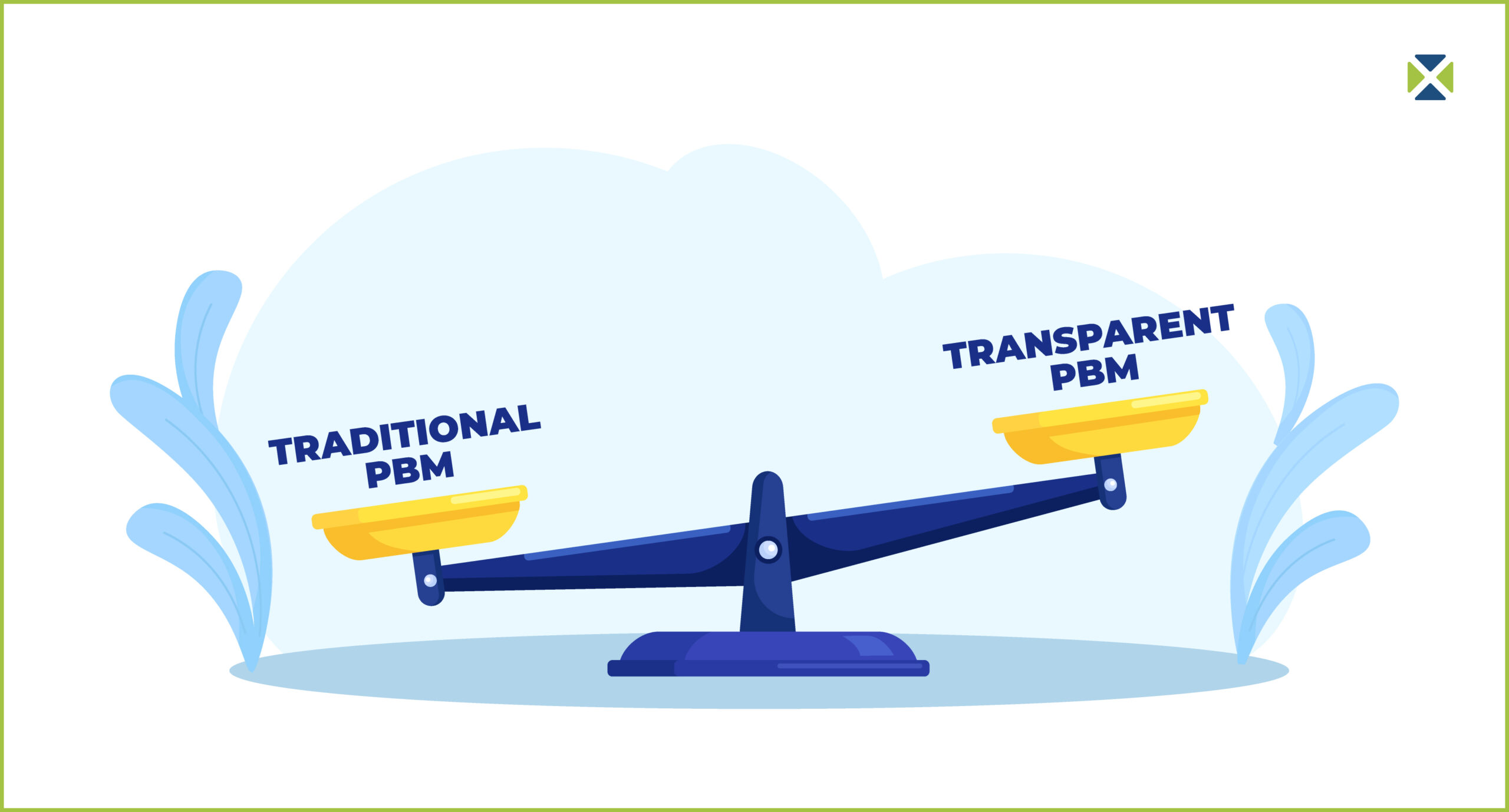Proven pharmacy benefit strategies to lower costs and improve employee coverage
Key takeaways
- Employer healthcare costs are rising, with a projected 9% increase in 2025, pushing average costs above $16,000 per employee.
- Pharmacy costs, especially high-cost specialty drugs, are a major driver of increased healthcare spending.
- Traditional PBMs add hidden fees, spread pricing, and rebate retention, making healthcare more expensive for employers.
- Transparent Pharmacy Benefit Solutions eliminate unnecessary costs through pass-through pricing and full rebate transparency.
- Brokers can help employers save by using an Rx Optimization Program, real-time data, and AI-driven cost management.
- Encouraging preventive care and offering customized PBM solutions can further reduce costs.
- Intercept Rx provides a transparent, cost-saving alternative with member-first benefits like $0 copays and free home delivery.
- Now is the time for brokers to evaluate PBM strategies and recommend cost-effective solutions to employers.

Rising employer healthcare costs: What can broker do?
If it feels like healthcare costs are skyrocketing every year, you’re not imagining it. Employers across the U.S. are feeling the financial squeeze as health plan expenses keep climbing, putting pressure on business budgets, employee benefits, and overall profitability.
Just how bad is it? In 2023, employer health plan costs jumped 7%, and another 6.5% increase was expected for 2024.¹ But that’s not all—Aon, a global professional services firm that provides risk management, insurance, reinsurance, and human capital consulting services, predicts a massive 9% spike for 2025, with the average cost per employee exceeding $16,000.²
So, what’s behind these rising costs? Inflation, rising drug prices, and the way traditional PBMs operate all play a role. Specialty medications, particularly high-cost GLP-1s for weight loss and diabetes, are more in demand than ever. On top of that, many traditional PBMs prioritize profits over cost-saving strategies, leaving employers stuck with higher bills.
That’s where brokers come in. Brokers have a unique opportunity to help employers reduce costs without sacrificing quality benefits—but only if they have the right strategies and partners in place.
In this guide, we’ll break down the biggest cost drivers, key cost-saving strategies, and why transparent Pharmacy Benefit Solutions (like Intercept Rx) are changing the game.
Ready to help your clients cut pharmacy spend and keep healthcare costs under control? Let’s dive in.
The biggest cost drivers behind rising employer healthcare spend
Healthcare costs aren’t just rising randomly—there are specific drivers pushing expenses higher every year. Employers need to understand these cost factors if they want to get their pharmacy spend under control. Let’s break down the biggest culprits:
1. Pharmacy costs are driving employer healthcare expenses higher than ever
Prescription drugs make up a huge portion of healthcare spending, and the costs just keep climbing. Specialty medications—like GLP-1s for weight loss and diabetes (think Wegovy and Ozempic)—are now some of the biggest cost drivers for employer-sponsored plans. While these medications can be life-changing, their high price tags are putting serious financial pressure on companies.
What does this mean for employers? Without the right pharmacy benefit strategy, they could be overspending on prescriptions without realizing it.
2. Traditional PBMs increase costs with hidden fees and rebate retention
Many employers assume their PBM is working in their best interest—but the truth is, traditional PBMs often profit from hidden fees and inflated drug costs.
Some of the biggest hidden costs include:
- Spread pricing: PBMs mark up drug costs, charging employers more than what the pharmacy actually paid.
- Rebate games: Instead of passing savings back to the employer, PBMs pocket a portion of the rebates from drug manufacturers.
- Opaque contracts: Complicated terms make it hard for employers to see where their money is going.
Without transparency, employers are often paying way more than necessary for prescription benefits.
3. How high-cost specialty drugs impact employer budgets
Specialty drugs are revolutionizing healthcare, treating chronic conditions, autoimmune diseases, and rare disorders—but they come at a steep price. The average annual cost for just one specialty medication can easily surpass $80,000 per patient.
For employers, this means:
- A single high-cost prescription can blow up their budget.
- Increased insurance premiums as carriers adjust for these rising expenses.
- Difficult cost predictions, making financial planning a nightmare.
The takeaway? If brokers want to help clients control costs, they need a transparent PBM solution that eliminates unnecessary spending and optimizes prescription benefits.

Transparent pharmacy benefit solutions: The key to lowering employer costs
By now, it’s clear that traditional PBMs aren’t designed to save employers money—they’re designed to maximize their own profits. That’s why more brokers are turning to Pharmacy Benefit Solutions like Intercept Rx, which focus on cost savings and transparency rather than hidden fees.
So, what makes a transparent PBM model different, and why should brokers be recommending it to their clients?
1. Why traditional PBMs are failing employers
Most traditional PBMs operate with a “black box” pricing model, making it difficult for employers to see where their money is actually going.
Common PBM profit tactics include:
- Spread pricing: PBMs charge employers more than what they reimburse pharmacies.
- Rebate retention: Instead of passing back savings, PBMs keep a large portion of manufacturer rebates.
- Opaque contracts: Complicated agreements make it nearly impossible to track drug costs, rebates, and hidden fees.
This results in higher overall costs for employers and unnecessary out-of-pocket expenses for employees.
2. How transparent PBM models reduce costs and increase savings
Unlike traditional PBMs, Pharmacy Benefit Solutions focus on cost transparency, fair pricing, and employer savings.
Here’s how Intercept Rx helps employers save:
- 100% rebate transparency: All manufacturer rebates go back to employers, reducing costs.
- No spread pricing: What you see is what you get—there are no inflated charges.
- Clear contracts: Employers know exactly where their money is going, with no surprises.
For more insights into how PBMs are evolving, check out this article: The Future of PBMs: From PBM to Pharmacy Benefit Solutions.
3. Why brokers should push for Transparent PBM models
Brokers have a unique opportunity to help employers reduce costs, eliminate waste, and improve employee benefits—but only if they partner with the right PBM.
A transparent, pass-through model like Intercept Rx allows brokers to:
- Help employers eliminate unnecessary spending and avoid hidden fees.
- Improve employee satisfaction by offering better pharmacy benefits at lower costs.
- Strengthen relationships with clients by providing cost-saving solutions that actually work.
At the end of the day, brokers who recommend transparent Pharmacy Benefit Solutions position themselves as trusted advisors while helping their clients control costs. The right PBM strategy isn’t just a competitive advantage—it’s a necessity in today’s rising healthcare landscape.

Key strategies brokers can use to reduce employer healthcare spend
Now that we’ve covered the biggest cost drivers, let’s talk about solutions. Brokers play a critical role in helping employers cut unnecessary spending without sacrificing the quality of their pharmacy benefits. The key? Partnering with the right Pharmacy Benefit Solutions provider and using proactive cost-saving strategies like these.
1. How an Rx Optimization Program can deliver significant savings
Traditional pharmacy plans are often inefficient and expensive—filled with hidden markups, misaligned incentives, and outdated pricing structures. That’s why employers need a smarter, more cost-effective approach, like an Rx Optimization Program.
With an Rx Optimization Program like Intercept Rx’s, employers can:
- Lower prescription costs through AI-powered claims processing.
- Reduce out-of-pocket expenses for employees by eliminating unnecessary fees.
- Improve access to medications with benefits like $0 copays, free home delivery, and member advocacy.
These strategies don’t just cut costs—they also boost employee satisfaction and retention, making pharmacy benefits a competitive advantage for businesses.
2. Using data and AI to control pharmacy costs and eliminate waste
Many employers overpay for pharmacy benefits simply because they don’t have the right data tools to track and manage spending. Real-time claims data and AI-driven cost management can make a huge difference in controlling pharmacy costs.
Here’s how:
- Identifying overspending and fraud: AI-powered tools can flag overpriced claims and ensure employers aren’t overpaying.
- Analyzing prescription trends: Employers can see which medications drive costs and adjust coverage accordingly.
- Preventing unnecessary expenses: Real-time data insights allow brokers and employers to make smarter, cost-saving decisions.
With Intercept Rx’s technology-driven solutions, brokers can help clients optimize their pharmacy spend while ensuring employees receive the medications they need.
3. Eliminate PBM middlemen & hidden fees
Not all PBMs operate the same way. Many traditional PBMs act as middlemen, inflating costs through spread pricing, hidden rebates, and complex contract terms.
A transparent PBM model eliminates these issues by:
- Removing unnecessary markups so employers only pay the actual cost of prescriptions.
- Ensuring 100% rebate pass-through, so all savings go back to the employer.
- Providing clear contracts with no hidden fees or surprise charges.
Brokers who help their clients evaluate their PBM contracts can identify cost-saving opportunities and switch to a more transparent provider like Intercept Rx.
For a deeper dive into this topic, check out: The Future of PBMs: From PBM to Pharmacy Benefit Solutions.
4. Encourage preventive care & medication adherence
One of the best ways to lower long-term healthcare costs is to invest in preventive care and ensure medication adherence. When employees take their medications as prescribed, they stay healthier, reducing the need for expensive medical interventions down the road.
How can brokers encourage better adherence?
- Recommend pharmacy plans with free home delivery, making it easier for employees to access medications.
- Offer member advocacy services to help employees understand their prescriptions and stay on track.
- Ensure lower out-of-pocket costs, so employees are less likely to skip doses due to affordability issues.
Intercept Rx offers personalized member support and cost-effective prescription management, helping employees stay on top of their treatment plans without breaking the bank.
5. Offering customizable pharmacy benefits for maximum savings
Every employer has different healthcare needs, which means a one-size-fits-all approach to pharmacy benefits just doesn’t work. Brokers should help their clients explore flexible PBM options that align with their workforce and financial goals.
Key strategies include:
- Optimizing self-funded and level-funded plans for cost efficiency.
- Offering tiered coverage options based on employer size and industry needs.
- Working with a PBM that provides custom formulary management, allowing employers to tailor their coverage to reduce costs and improve care access.
By choosing a PBM that prioritizes flexibility and transparency, brokers can help employers maximize their pharmacy benefits while keeping costs low.

Why brokers should rethink their PBM strategy now
The pharmacy benefits landscape is shifting, and brokers who adapt will be the ones leading the way. With employer healthcare costs hitting record highs, sticking with traditional PBMs could be costing businesses millions in unnecessary expenses. It’s time for brokers to take a proactive approach and rethink how they’re managing pharmacy benefits for their clients.
Here’s why making the switch to Pharmacy Benefit Solutions is more important than ever.
1. How the wrong PBM is costing employers millions in healthcare spend
Employers who continue using traditional PBMs are often paying for:
- Hidden fees and markups that drive up costs.
- Rebate withholding instead of passing savings back to the employer.
- Lack of pricing transparency, making it difficult to track spending.
Brokers who don’t question these costs could be losing trust with their clients. Businesses are actively looking for cost-saving strategies, and brokers who fail to present better options risk falling behind in a competitive market.
2. Intercept Rx is redefining Pharmacy Benefit Solutions
Employers need a smarter, more transparent way to manage pharmacy costs. That’s where Intercept Rx comes in.
What makes Intercept Rx different?
- True transparency: No hidden fees, no spread pricing, and 100% rebate pass-through.
- Rx Optimization Program: Employers save money while ensuring employees get the medications they need.
- Technology-driven savings: AI-powered cost management to reduce waste and control spending.
- Member advocacy: Free home delivery, $0 copays, and dedicated support for employees.
Brokers who partner with Intercept Rx can offer clients a better way to manage pharmacy benefits—one that saves money and prioritizes members.
3. Brokers: Now is the time to act
The healthcare market is changing fast, and waiting too long to adapt could mean missing out on valuable savings opportunities for employers. Brokers who take the initiative to switch to a Pharmacy Benefit Solutions model will be the ones delivering real results to their clients.
Now is the time to:
- Review current PBM contracts and identify cost inefficiencies.
- Explore transparent, cost-saving alternatives like Intercept Rx.
- Take a leadership role in reducing employer healthcare spend.
Take the next step: Learn more about Intercept Rx
Brokers who want to help their clients cut healthcare costs need a PBM partner that’s built for transparency and savings.
Explore how Intercept Rx compares to competitors:
📌 Intercept Rx vs. Competitors: How We Deliver Superior Savings
Check out cost-saving strategies:
📌 Strategies for Employers to Reduce Healthcare Costs as Insurance Premiums Rise
Find out if it’s time to switch PBMs:
📌 Top 7 Signs It’s Time for a New PBM
The future of pharmacy benefits is here—and brokers who embrace transparency and cost optimization will be the ones leading the charge.
Final thoughts: How brokers can lead the way in lowering employer healthcare costs
Employers are under more pressure than ever to control healthcare spending. Brokers have the power to deliver real savings, but they need the right partners to make it happen.
By moving away from traditional PBMs and toward Pharmacy Benefit Solutions, brokers can help employers save money, improve employee satisfaction, and stay competitive in today’s evolving healthcare landscape.
It’s time to rethink PBMs.
It’s time for a better pharmacy benefits strategy.
It’s time for Intercept Rx.




